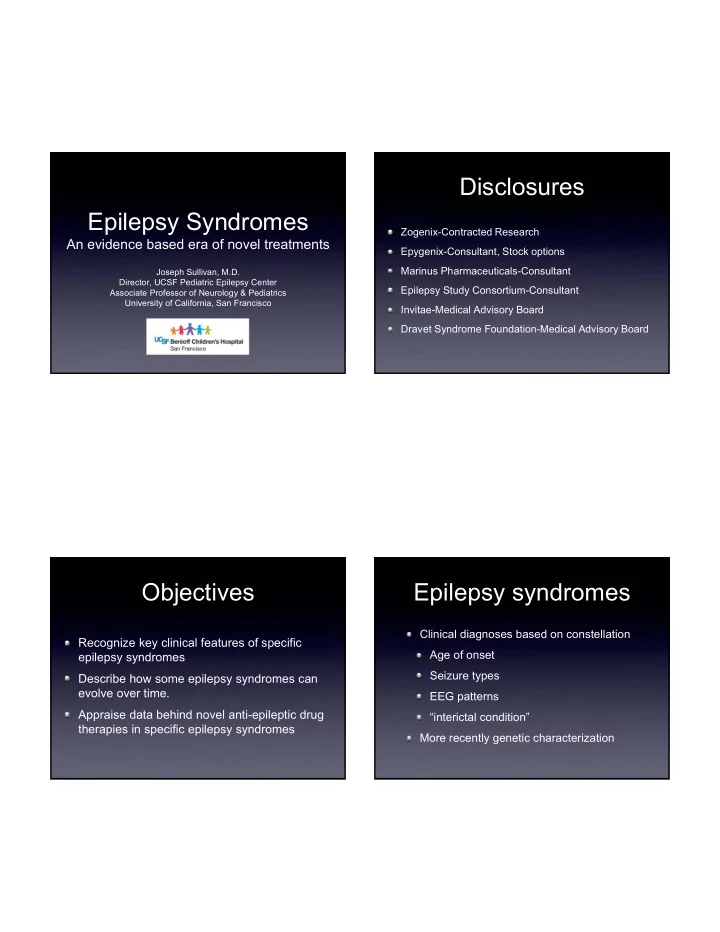

Disclosures Epilepsy Syndromes Zogenix-Contracted Research An evidence based era of novel treatments Epygenix-Consultant, Stock options Marinus Pharmaceuticals-Consultant Joseph Sullivan, M.D. Director, UCSF Pediatric Epilepsy Center Epilepsy Study Consortium-Consultant Associate Professor of Neurology & Pediatrics University of California, San Francisco Invitae-Medical Advisory Board Dravet Syndrome Foundation-Medical Advisory Board Objectives Epilepsy syndromes Clinical diagnoses based on constellation Recognize key clinical features of specific Age of onset epilepsy syndromes Seizure types Describe how some epilepsy syndromes can evolve over time. EEG patterns Appraise data behind novel anti-epileptic drug “interictal condition” therapies in specific epilepsy syndromes More recently genetic characterization
Why? Case #1 8-month old male infant with normal birth More accurate diagnosis history presents to the office stating he Improved management seems to be startling “like when he was a baby”. The episodes occur more often on Targeted work-up awakening and last “15 minutes” Counseling and prognosis Exam is normal and no episodes are Genetic counseling witnessed Hypsarrhythmia Infantile Spasms/West Syndrome
ASSIST Study Age onset 4-9 months • flexor/extensor “spasm”, clusters 20-40 spasms 5-30 seconds apart Seizure • may have some asymmetric features, may involved neck or eyes only semiology Survey of 100 patients with IS • classical hypsarrhythmia-high voltage, disorganized, random spikes and EEG slow waves • may only be apparent during drowsiness or sleep Latency of first visit with an “effective provider” findings • look for focal/asymmetric features • if EEG normal-be sure to capture sleep, repeat in 2 weeks Median time was 24.5 days • malformations of cortical development or ischemic injury in 60-90% • neurocutaneous syndromes, ie TSC, NF Etiology Only 29% evaluated within 1 week • genetic diseases=X-linked lissencephaly, Down’s syndrome • “cryptogenic” (40% have family history of epilepsy) “something is wrong” was often discounted • Steroids (ACTH, hydrocortisone, prednisolone) • vigabatrin Treatment • valproate, topiramate, zonisamide, vitamin B6 Respondents stated pediatricians and neurologists • surgery in cases of isolated cortical dysplasia were unfamiliar with infantile spasms • spasms often remit spontaneousluy-evolve into other seizure types • 11% may have NORMAL cognitive outcome (cryptogenic cases) Prognosis • 20% die, usually in first 2 years • 70-80% have MR (50% severe) Hussain SA, et al, J Pediatric, Nov 2017 Emerging Treatment Paradigms Case #2 10-month old female infant with normal birth history presents to your office after being discharged from the ER the night before after having her 2nd febrile seizure. First seizure was at 6 months 2 days after vaccines and lasted 15 minutes. The seizure last night was Vigabatrin PLUS hormonal-72% spasm free 10 minutes and seemed to be only on one Hormonal therapy alone-57% spasm free side, and she was diagnosed with AOM (acute otitis media). 11 pt IQ decline in those patients with spasms >1 month Lancet Neurol, Jan 2017
Case #2 Development is normal, starting to cruise Dravet Syndrome and can say mama and dada. No Family history of epilepsy Neurologic exam is normal Core Phenotype When to suspect? Onset of convulsion prior to 1 year of age Usually between 5-8 months Often prolonged >10 minutes Previously NORMAL development Next months additional febrile or afebrile seizures occur Vaccine proximate-earlier onset, similar outcomes Clinical score >6 SCN1A testing Ages 1-4- Various additional seizure types occur Dravet C, Epilepsia 2011 Hattori J, Epilepsia 2008 McIntosh AM Lancet Neurol 2010
CBD 5% seizure free vs 0 in placebo Devinksy O & Cross JH, NEJM, 376;21 May 25,2017 Devinksy O & Cross JH, NEJM, 376;21 May 25,2017 Fenfluramine in Dravet Dravet study Ceulemans et.al. Epilepsia 2012 53(7) Cross H, et al. AES Poster 2016
Primary Endpoint Adverse Events 93% Treatment vs 75% Placebo Diarrhea Decreased appetite Vomiting Lethargy Fatigue Somnolence Pyrexia Fatigue URI Lagae L & Sullivan J, AES 2017 2.434 Devinksy O & Cross JH, NEJM, 376;21 May 25,2017 Case #3 CBD conclusions 4 year old boy with history of infantile spasms/West syndrome, responded favorably to treatment presents with new type of spells When standing he will have an abrupt fall. When Anecdotal experience led to well designed placebo sleeping appears to stiffen as if he is trying to controlled trials stretch. Appears to be safe, well-tolerated and effective in reducing seizures in Dravet Syndrome History significant for developmental delay Mechanisms of action of various cannabinoids also Walked at 20 months remains poorly understood No expressive speech, follows simple Role of other cannabinoids needs further study commands
Age onset Ages 3-10, peak 3-5, unusual after age 8 • tonic axial seizures • atonic • atypical absence-gradual onset & offset, may not completely lose Seizure consciousness semiology • may be accompanied by oral myoclonias • non-convulsive status is common • Generalized tonic-clonic are relatively uncommon • almost always abnormal at onset EEG • slow and poorly organized • diffuse slow spike/wave (2-2.5 Hz), anterior predominance findings • paroxysmal fast activity during sleep (clinical or no clinical signs) • cerebral dysgenesis/dysplasia • may follow infantile spasms/West Syndrome Etiology • Associated with Down’s, Angelman’s • few autopsy specimen’s show dysplastic cortex • largely unknown • valproate, lamotrigine (possibly together) • benzodiapzepines Treatment • felbamate • Cannabidiol • severe MR in 45-50% • chronic treatment resistant seizures with variable evolution Prognosis • atonic seizures may decrease with age, tonic seizure may become Devinsky O, et al, NEJM, May 2018 prolonged Conclusions Epilepsy syndromes can evolve over time Need to be aware of evolution as optimal treatment options may also evolve Specific epilepsy syndromes have allowed the study and subsequent FDA approval of novel compounds Most treatment resistant epilepsy syndromes should be referred to an epileptologist for tailored treatment approach Devinsky O, et al, NEJM, May 2018
Recommend
More recommend